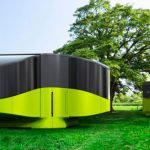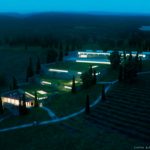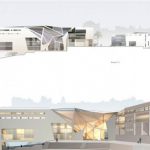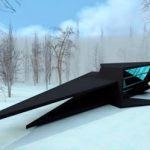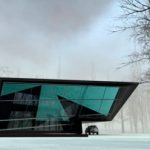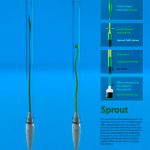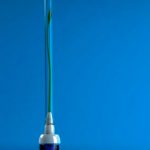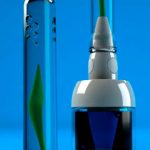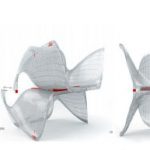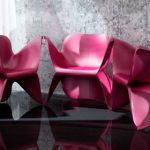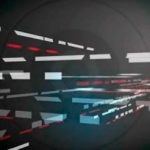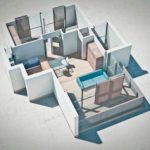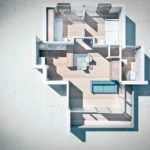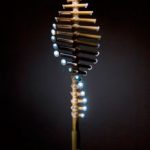NOMINATION: FORM
Olga Kalugina (Russia, Ekaterinburg)
Ural State Academy of Architecture and Art / graduated
Mobile living module
The Mobile living module runs on renewable energy sources. And as a Mobile living module, BLOOM is designed to rely on nature far from a civilization. The module works completely independently on renewable energy sources. The object is equipped by solar batteries, air and liquid solar collectors, water treating filters, a slow burning furnace and a system for processing dust. The module transforms so lateral parts of it are developed from the inside out, considerably increasing internal space of the module.
Module audience will be travel companies, which will organize trips to places chosen by the client. The module is intended for six persons from three days to about one week. The module is transported by means of motor transport or helicopter. The size of the module is comparable to the sizes of standard containers, but it is possible to connect modules together. The living space includes the entrance zone, three private living zones and the general territory in which you’ll find a dining zone, a sanitary-and-hygienic block, and a kitchen. The private living zone is an open room for two people. The first berth becomes a top shelf. The second berth is transformed to a sofa and a bench in the afternoon, separating a work space from the general zone.
Alexandra Gineva (Russia, Moscow region)
Moscow Institute of Architecture, Hogeschool voor Wetenschap en Kunst Sint-Lucas / student
Winery
The projected complex of the winery is for a location in the Krasnodar region, outside a village called Moldavanskoe, where it should become part of a multifunctional tourist complex, Lefkadia. This hilly terrain with small rivers and lakes is best suited to a spa resort, and to the planting of vineyards. So the best solution is to combine these functions and create a recreation complex, which will be the basis for wine making, wine culture and aesthetics.
Anna Sergeevna/Mokropova (Ukraine, Kiev)
Kiev National University of Engieneering and Architecture / student, bachelors degree
Project of Student Center
The concept of urban student centre includes construction of a new type of building and creation of an attractive public space, set in the environment of a future landscape park. The municipal communication and/or informational student centre is a cutting-edge social facility for public use. It allows for all forms of communication and informational exchange. And it covers needs of students by providing a full range of services including counseling, career advice consultations, workshops, conferences and exhibitions.
The centre also provides services in the newest field of web technologies, “cloud computing“. It includes an information and communication centre, a café, a sports area, a mini-hotel and an informal communication and recreation zone in the atrium space. This complex is planned as unique place where students can relax, communicate with ease, expand skills, work on professional, cultural and social projects, and engage in research. The building works topographically, organizing an open square in front of the main entrance, which separates the complex from the highway, creating an urban green zone with terraced alleys and access to the lake. Alleyways are linked through the main entrance, an atrium, covered by transparent dome. Following local topography, the building’s left wing dips into a green park. Meanwhile, the right wing of the complex is elevated above the ground, revealing a park zone. A straight line is softened by the glass dome, connecting the two parts of the building and providing internal spaces with direct sunlight.
Beka Pkhakadze (Georgia, Tbilisi)
Georgia Institute of Technology / student of magistracy
House In The Forest
One day I was sitting in my office surrounded by the noisy crowd and the dirty, dusty air of the capital caused by the massive pollution of endless people circulation. Trying not to be bored of all these circumstances, I was searching for new idea how to insulate myself from a hostile environment. While standing on the inner side of a big office window, which separates my workspace from reality of capital, inspiration struck with an idea for a polar opposite place to enjoy my job. In the blink of an eye, I sketched all aspects of my new creation on a page of my sketchbook. To put it in simple terms, opposite means the difference between winter and summer, city and forest, to change the old with the new in a completely different place: good music, a cup of coffee and a cigarette, comfortable chair, pencil to think and PC to work. The list above is good enough for me to enjoy my work as an architect so let’s see where it leads. «We must become the change we want to see» (Gandhi).
NOMINATION: ICON
Igor Lobanov (Russia, Kurgan)
Ural State Academy of Architecture and Art / graduated
Sprout
The main feature of the developed pen – the structure of a core for ink – reminds me of a plant stalk, a sprout under the form. When combined with the colour of the ink, the Sprout pen core cover takes on a green natural colour. As you write, as the ink is spent, the stalk develops, like a withering plant, and its colour becomes more yellow. But complete with the pen there is a special stand. When the pen sits in here, it is slowly filled with fresh ink.
Nina Gruszczynska (Poland, Warsaw)
Academy of Fine Arts / graduated
Manta Ray
Urban bench ‘Manta Ray’ is inspired by the world of living organisms, particularly by manta, a fish whith a quite complicated form that also maintains perfect symmetry. My objective was to keep this rule during designing.
The form is dynamic. It doesn’t contain any straight or perpendicular lines, and that gives the impression of being ‘alive’. The lines echo are repeating the streamlined organic form of this intriguing animal. This mild shape without sharp corners invites you to sit here
My goal was to design urban sculpture with a function, not furniture as such. That’s why my inspirations were not only designers, but particularly sculptors. From this basis, I created a light, open composition incorporating air into the structure. The effect was achieved by working with surfaces, not solids, which I started modelling using wire mesh to give me this special flexibility.
The bench can be used as a standalone piece, as a part of any composition and as a module in a linear ‘growing’ structure. There are many possibilities of arrangements.
The technology that I would use to produce this bench is Injection Technology, which meets the needs of the future design, allowing to execute seamless forms with infinite number of finishes- colours and structures in the ecological way.
NOMINATION: CAST
Michal Wroblewski (Poland, Radomsko)
Institute of fine arts in Czestochowa / graduated
NTL Kurier
Creating the credits for TV news called Kurier, I wanted to show the principles on which the programme is based and present the cities in which NTL channel can be received. Radomsko is the information centre and it is surrounded by the other cities, regarding their geographical position. The whole project presents a symbolic map of pulsating circumferences, which suggest the flow of information. This project is a part of NTL channel’s layout and a part of my graduation work.
NTL Sport
The credits for the sport programme are created by means of lines which symbolise space and dynamics. However, the objects and shapes characteristic of sport are not be find here. This project is a part of NTL channel’s layout and a part of my graduation work.
NTL Pogoda
The credits for the weather forecast, in which we can see the typical elements of weather: an umbrella, the rain and the sun, interpenetrating each other. The wholeness has the complex colouring, oscillating between sky-blue, yellow, white, orange and red. This project is a part of NTL channel’s layout and a part of my graduation work.
Alexander Dobrovskiy (Russia, Moscow)
Moscow Institute of Architecture, Hogeschool voor Wetenschap en Kunst Sint-Lucas / student
Seaport Sakhalin
A projected sea port could be placed on the shelf of Sakhalin island, near the village of Ilyinsky. The port could be part of the program for development of the transport system in Russia from 2010 to 2015. The site selected for the project comes from the fact that the island of Sakhalin is in need of a modern port to link with the mainland.
This port will serve the projects Sakhalin 3, 4, 5, 6, 7, 8, 9 (passenger and commercial ships). The advantages of the chosen location are: the availability of sufficient land, proximity to rail, road and highway, the possibility of year-round pilotage with no icebreaker needed (ice from only January to March does not interfere with shipping). The port will be an alternative to the outdated port in Kholmsk and will be the main link to an existng port, Vanino. The aims of the project are ensuring the development of Sakhalin territory, designing a hub to connectof the island with the mainland, a way to solve current economic problems with the creation of an additional third exit to the Pacific Ocean.
Francesca Pozzi (Italy, Milan)
Politecnico di Milano / graduated
Urban Apartment
This is an architectural project that aims to present some exercises about flexibility. Different plans in its configuration mean flexibility of use. These are some 3d images of an urban apartment where these principles have been applied.
Alberto Vasquez (Hungary, Budapest)
MOME, Moholy-Nagy University of Art and Design / graduated
‘Flow’ – public light for the Third World
‘Flow’ is a bamboo-made, self-maintaining public lighting system which operates on the principle of vertical wind turbine. The whole lamp disintegrates in nature except for the electronics – LEDs, wires and dynamo – which after time can be recycled without down-cycling. It can be installed in any place beyond the reach of the electric grid and solve the lack of public lighting there. Due to the simple junctions and mechanics, it can also be produced by the local unskilled workforce.
I was inspired by a problem that I experienced in Cartagena (Colombia). The coast-side of the city is busy and safe by day, but in the night it is dangerous because it’s abandoned. The reason behind this is the lack of public lighting at the seacoast. It is near deserted because few activities can be done in total darkness. But locals and tourists still have the desire to be at the seaside by night. If the coast stays busy after dark it won’t be dangerous anymore.
The electrical grid cannot be transmitted to the shores because of the attributions of soil and environmental conditions. The maintenance of the public lights and the building of the grid is too expensive – for such a developing country – as does the consuming of electricity.
In Colombia there is a need of lighting which is cheap, which can be installed at places beyond the power grid and which is economically sustainable. How do we get electrical energy for the lighting? The wind dominating the shores in the whole year is an ideal resource for the lighting. That’s why ‘Flow’ works as a vertical wind turbine – to maintain its own power. Therefore the energy consumption from the grid is zero. How will this be cheap? Bamboo is one of the easiest to find and cheapest to produce raw materials in Colombia and its utilization has no ecological impact even at medium serial number products. It was socially important that the lamp can be produced by the locals, thus it can integrate to the area’s cultural and economic rhythm. Due to the simple construction and mechanics of the Flow lamp, it can also be produced by the local unskilled workforce. Therefore the whole lamp can be manufactured locally. This makes it even cheaper because it circumvents most logistical and transportation costs. As it can be produced by the local workforce it can reduce unemployment – which affects 40% of Colombia’s population today. It can give jobs for poor and uneducated people and let the coast side of Cartagena be busy and safe by night.
During the research process I realized that there are lot of countries with similar issues. In Third World countries the lack of public lighting is a common problem. The reasons are that in these places the building of an electric grid is too expensive or not even possible. There are not enough resources at hand: not enough raw materials, money and skilled workforce for the production.
But there is a need of lighting which is cheap, can be installed at places which cannot reach the network and can be easily produced with local resources. At these places the cheapest and most plentiful raw material is bamboo, while the cheapest utility energy is wind energy.











